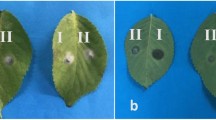Abstract
Recently, disease in broccoli plants (Brassica oleracea var. italica) was associated with three distinct phytoplasmas in Brazil. The disease named broccoli stunt (BS) has caused significant economic losses in São Paulo State. Group 16SrIII phytoplasmas is the most common group that have been associated with BS. The BS disease is still poorly understood, and the lack of information about the vectors further impairs its management. In this study, leafhoppers belonging to 18 different species were collected from weeds thriving near broccoli fields that were affected by group 16SrIII phytoplasmas. Specific primers revealed the presence of group 16SrIII phytoplasmas in five leafhoppers: Empoasca spp., Agallia albidula Uhler, Agalliana sticticollis (Stål), Planicephalus flavicosta (Stål), and Atanus nitidus (Linnavuori). The identity of the phytoplasmas was confirmed through DNA sequencing analysis. The leafhoppers were infected by phytoplasmas of the 16SrIII group (proposed “Candidatus Phytoplasma pruni” species) and are phylogenetically related to the broccoli stunt phytoplasma (BSP) strains detected in the study area and, thus, are considered potential vectors of group 16SrIII phytoplasmas to broccoli plants.

Similar content being viewed by others
References
Altschul SF, Madden TL, Schäffer AA, Zhang J, Zhang Z, Miller W, Lipman DJ (1997) Gapped BLAST and PSI-BLAST: a new generation of protein database search programs. Nuclei Acids Res 25:3389–3402
Catalani MI (2011) Cicadélidos vectores de fitoplasmas a cultivos de importancia económica en la Argentina. PhD thesis, Universidade Nacional de La Plata
Dabek AJ (1982) Transmission experiments on coconut lethal yellowing disease with Deltocephalus flavicosta Stal, a leafhopper vector of phyllody in Jamaica. Phytopathol Z 103:109–119
Deng S, Hiruki C (1991) Amplification of 16SrRNA genes from culturable and non-culturable mollicutes. J Microbiol Meth 14:53–61
Eckstein B, Barbosa JC, Kreyci PF, Canale MC, Brunelli KR, Bedendo IP (2013) Broccoli stunt, a new disease in broccoli plants is associated with three distinct phytoplasma groups in Brazil. J Phytopathol 161:442–444
FNP Consultoria and Comércio (2013) Agrianual 2013: anuário da agricultura brasileira. Editora Informa economics FNP, São Paulo, SP, Brazil, pp480
Galetto L, Marzachi C, Demichelis S, Bosco D (2011) Host plant determines the phytoplasma transmission competence of Empoasca decipiens (Hemiptera: Cicadellidae). J Econ Entomol 104:360–366
Gundersen DE, Lee IM (1996) Ultrasensitive detection of phytoplasmas by nested-PCR assays using two universal primer pairs. Phytopathol Mediterr 35:144–151
Hogenhout SA, Oshima K, Ammar E-D, Kakizawa S, Kingdom H, Namba S (2008) Phytoplasmas: bacteria that manipulate plants and insects. Mol Plant Pathol 9:403–423
IRPCM Phytoplasma/Spiroplasma Working Team-Phytoplasma Taxonomy Group (2004) Int J Syst Evol Micr 54:1243–1255
Lee I-M, Gundersen DE, Hammond RW, Davis RE (1994) Use of mycoplasmalike organism (MLO) group-specific oligonucleotide primers for nested-PCR assays to detect mixed-MLO infections in a single host plant. Phytopathology 84:559–566
Lee I-M, Gundersen-Rindal DE, Davis RE, Bartoszyk IM (1998) Revised classification scheme of phytoplasmas based on RFLP analyses of 16S rRNA ribosomal protein gene sequences. Int J Syst Bacteriol 48:1153–1169
Marzachi C, Veratti F, Bosco D (1998) Direct PCR detection of phytoplasmas in experimentally infected insects. Ann Appl Biol 133:45–54
Montano HG, Cunha Junior JO, Pimentel JP (2011) Phytoplasmas in Brazil: an update. Bulletin of Insectology 64:S251–S252
Nault R (1980) Maize bushy stunt and corn stunt: a comparison of disease symptoms, pathogen host ranges, and vectors. Phytopathology 70:659–662
Pérez KC, Pinõl B, Rosete YA, Wilson M, Boa E, Lucas J (2010) Transmission of the Phytoplasma Associated with Bunchy Top Symptom of Papaya by Empoasca papayae Oman. J Phytopathol 158:194–196
Rapussi MCC, Eckstein B, Flôres D, Haas ICR, Amorim L, Bedendo IP (2012) Cauliflower stunt associated with a phytoplasma of subgroup 16SrIII-J and the spatial patter of disease. Eur J Plant Pathol 133:829–840
Smart CD, Schneider B, Blomquist CL, Guerra LJ, Harrison NA, Ahrens U, Lorenz K-H, Seemüller E, Kirkpatrick BC (1996) Phytoplasm-specific PCR primer based on sequences of the 16S-23S rRNA spacer region. Appl Environ Microbiol 62:2988–2993
Tamura K, Dudley J, Nei M, Kumar S (2007) MEGA 4: molecular evolutionary genetics analysis (MEGA) software version 4.0. Mol Biol Evol 24:2596–1599
Vega FE, Davis RE, Barbosa P, Dally EL, Purcell AH, Lee I-M (1993) Detection of a plant pathogen in a non-vector insect species by the polymerase chain reaction. Phytopathology 83:621–624
Weintraub PG, Beanland L (2006) Insect vectors of phytoplasmas. Annu Rev Entomol 59:91–111
Acknowledgments
The authors are grateful to Buonogel group for conceding the experimental area, and to Fundação de Amparo à Pesquisa do Estado de São Paulo, FAPESP, for financial support (project number 2008/58450-3). Fellowships from Conselho Nacional de Desenvolvimento Científico e Tecnológico (CNPq) to A. C. G. through Ciência sem Fronteiras (CsF) program, process 237427/2012-5, and from Lemann Foundation, are acknowledged.
Author information
Authors and Affiliations
Corresponding author
Rights and permissions
About this article
Cite this article
Eckstein, B., Barbosa, J.C., Kreyci, P.F. et al. Identification of potential leafhoppers vectors of phytoplasmas (16SrIII group) associated with broccoli stunt disease in Brazil. Australasian Plant Pathol. 43, 459–463 (2014). https://doi.org/10.1007/s13313-014-0293-8
Received:
Accepted:
Published:
Issue Date:
DOI: https://doi.org/10.1007/s13313-014-0293-8




